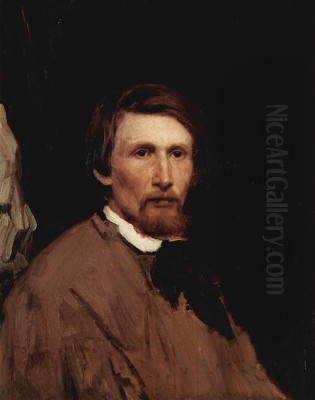
Viktor Mikhailovich Vasnetsov stands as a pivotal figure in the history of Russian art. Born on May 15, 1848, and living until July 23, 1926, his long and productive life witnessed profound changes in Russian society and art. Vasnetsov is celebrated primarily as a painter, but his talents extended to illustration and architecture, making him a versatile and influential creative force. He is widely regarded as a key founder of the Russian Romantic nationalist movement and a vital contributor to the folk art revival that sought to define a distinctly Russian artistic identity towards the end of the 19th century. His work masterfully blends realism with myth, history with folklore, creating a unique visual language that continues to resonate.
Early Life and Artistic Awakening
Viktor Vasnetsov was born in the remote village of Lopyal in the Vyatka Governorate of the Russian Empire. His background was modest; his father, Mikhail Vasilievich Vasnetsov, was a village priest with a keen interest in natural science, astronomy, and painting, which likely nurtured Viktor's early artistic inclinations. His grandfather was an icon painter. This clerical and rural upbringing immersed the young Vasnetsov in the traditional life, religious customs, and rich folklore of provincial Russia, themes that would later dominate his artistic output.
Showing promise in art from a young age, Vasnetsov began his formal education not in art, but theology. Following family tradition, he entered the Vyatka Theological Seminary in 1858. However, his passion lay elsewhere. While studying at the seminary, he also worked for a local icon shop and assisted the exiled Polish artist Michał Elwiro Andriolli with frescoes for the Alexander Nevsky Cathedral in Vyatka. This practical experience solidified his desire to pursue art professionally.
Recognizing his true calling, Vasnetsov auctioned two of his early paintings, The Milkmaid and The Reaper (both 1867), to fund his move to the imperial capital. In 1867, he left the seminary before completing his studies and traveled to St. Petersburg, determined to enter the prestigious Imperial Academy of Arts. Although he initially failed the entrance exams, he persevered, studying first at the Imperial Society for the Encouragement of the Arts, where he met fellow aspiring artists.
Academic Training and the Influence of Realism
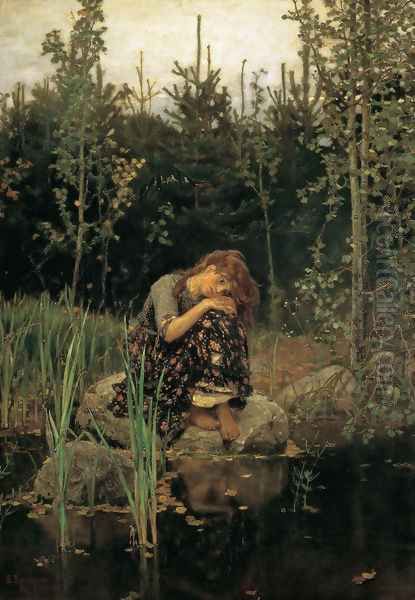
In 1868, Vasnetsov successfully entered the Imperial Academy of Arts. He studied there until 1875, honing his technical skills under influential professors like Pavel Chistyakov, a renowned teacher whose pupils included many of the era's greatest Russian artists, such as Ilya Repin, Vasily Surikov, Valentin Serov, and Mikhail Vrubel. During his time at the Academy, Vasnetsov developed friendships that would last a lifetime, most notably with Ilya Repin, who became a close confidant and artistic colleague.
In these early years, Vasnetsov aligned himself with the burgeoning Realist movement, particularly the Peredvizhniki (The Wanderers). This group, formally the Society for Travelling Art Exhibitions, emerged in the 1860s and 70s, breaking away from the strictures of academic art. Led intellectually by figures like Ivan Kramskoi, whom Vasnetsov deeply respected and referred to as his "teacher," the Peredvizhniki aimed to depict contemporary Russian life with truthfulness and social awareness, making art accessible to a wider public through traveling exhibitions.
Vasnetsov's early works reflect the Peredvizhniki ethos. He created genre scenes depicting the lives of ordinary people, often with a touch of gentle melancholy or social observation. Paintings like Moving House (1876) and Reading a War Telegram (1878) showcase his skill in realistic portrayal and narrative composition. He gained recognition within the movement, exhibiting with the Wanderers and contributing to their goal of creating a national art rooted in Russian reality.
A Turn Towards National Heritage: Folklore and History
Despite his success within the Realist framework, Vasnetsov felt an increasing pull towards different themes. The late 1870s marked a significant turning point in his career. He began to move away from contemporary genre scenes and delve into the rich tapestry of Russian folklore, medieval history, and epic legends (byliny). This shift was partly inspired by his deep-seated connection to the traditional culture of his childhood and a growing desire, shared by many intellectuals and artists of the time, to explore and celebrate Russia's unique national identity.
His travels also played a role. A period spent in Paris in the mid-1870s exposed him to different artistic currents, but ultimately seemed to reinforce his commitment to distinctly Russian themes upon his return. He became associated with the Abramtsevo Colony, an estate near Moscow owned by the wealthy industrialist and arts patron Savva Mamontov. Abramtsevo became a vibrant center for the Slavic Revival movement, attracting artists like Repin, Vrubel, Serov, Konstantin Korovin, and Vasily Polenov. Here, artists collaborated, experimented with folk crafts, and immersed themselves in Russian history and myth, fostering an environment conducive to Vasnetsov's evolving interests.
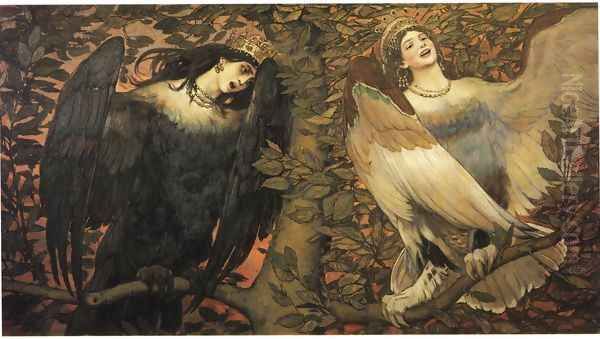
This period saw the creation of some of Vasnetsov's most iconic works, paintings that would define his legacy. After Prince Igor's Battle with the Polovtsy (1880) was one of the first major history paintings signaling his new direction. It depicted a somber, poetic scene from the medieval epic The Tale of Igor's Campaign, demonstrating his ability to infuse historical subjects with emotional depth and a sense of timeless myth.
The Birth of the 'Russian Style'
Vasnetsov became a key architect of what is often termed the "Neo-Russian" or "Russian Style" in painting. This style sought to create a modern artistic language deeply rooted in national traditions. It involved not just the depiction of Russian subjects, but a stylistic synthesis drawing inspiration from medieval Russian icon painting, folk art (lubok prints, embroidery, wood carving), Byzantine traditions, and contemporary European movements like Symbolism and Art Nouveau, all filtered through Vasnetsov's unique romantic vision.
His paintings from the 1880s and 1890s are characterized by their epic scope, decorative qualities, rich color palettes, and poetic atmosphere. He brought the heroes and heroines of Russian folklore to life with unprecedented grandeur and psychological depth. The Flying Carpet (1880) and Alenushka (1881), depicting a melancholic girl from a Russian fairy tale seated by a dark pond, showcase his ability to convey mood and narrative through landscape and figure.
Perhaps his most famous work, The Bogatyrs (also known as Three Heroes), occupied him for almost two decades, finally being completed in 1898. This monumental canvas depicts the three legendary epic knights Ilya Muromets, Dobrynya Nikitich, and Alyosha Popovich, standing guard over the Russian land. It became an instant national symbol, embodying Russian strength, resilience, and connection to its mythic past. Other major works exploring folklore include Ivan Tsarevich Riding the Grey Wolf (1889) and Sirin and Alkonost: Birds of Joy and Sorrow (1896).
Vasnetsov also masterfully rendered fairy tale scenes, often commissioned by Savva Mamontov or inspired by theatrical productions. The Snow Maiden (Snegurochka), a recurring theme he explored in painting and stage design, captures the ethereal beauty and tragic nature of the folk character. The Sleeping Princess is another example of his ability to translate beloved tales into visually stunning and emotionally resonant images. These works elevated folk narratives, previously considered material for popular or children's illustration, into the realm of high art.
Monumental Art: Murals and Religious Painting
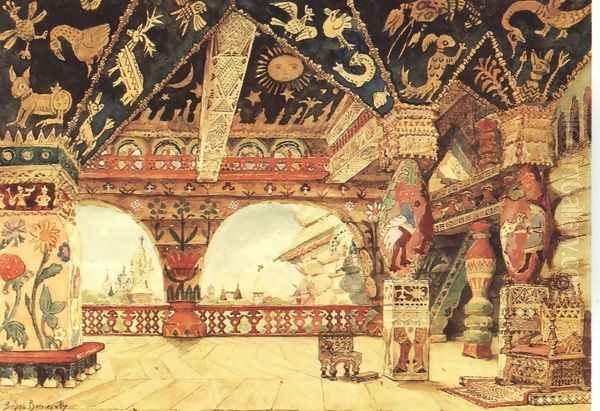
Vasnetsov's artistic vision extended beyond easel painting to monumental decorative projects, particularly religious murals. His deep understanding of Russian Orthodoxy, combined with his artistic style rooted in national traditions, made him uniquely suited for church decoration. His most significant commission came in 1885: the decoration of the newly built St. Vladimir's Cathedral in Kiev.
For over a decade (1885-1896), Vasnetsov labored on the vast cycle of frescoes covering the cathedral's interior. He worked alongside other prominent artists, including Mikhail Nesterov, but Vasnetsov was responsible for the central nave and main iconostasis. His murals, including the powerful Christ the Almighty in the main dome, The Last Judgment on the west wall, and numerous depictions of saints and biblical scenes, represent a remarkable synthesis of Byzantine artistic canons, Russian icon painting traditions, and modern artistic sensibilities.
The St. Vladimir's Cathedral murals were groundbreaking. They moved away from the drier academic style often seen in 19th-century church art, infusing the sacred space with emotional intensity, vibrant color, and a distinctly Russian spiritual feeling. While some critics found his interpretations too modern or theatrical, the murals were widely acclaimed and cemented Vasnetsov's reputation as a leading figure in the revival of Russian religious art. He effectively created a new standard for monumental church painting.
Prior to the Kiev project, Vasnetsov had also undertaken a significant secular mural commission. Between 1883 and 1885, he painted The Stone Age for the State Historical Museum in Moscow. This large frieze, depicting scenes from prehistoric life on the East European Plain, showcased his ability to handle historical themes on an epic scale, blending archaeological detail with imaginative reconstruction.
Architecture and Design: A Holistic Vision
Vasnetsov's commitment to the Russian Style extended into the realms of architecture and applied arts. He believed in the synthesis of arts, envisioning a total aesthetic environment inspired by national heritage. His most personal architectural statement was his own house in Moscow, built between 1893 and 1894 according to his own designs.
Located in a quiet lane (now named Vasnetsov Lane), the house is a fairy-tale structure, a charming embodiment of the Neo-Russian style. With its intricately carved wooden details, traditional roof shapes (terem-like), and interiors featuring furniture and objects designed by Vasnetsov and his brother Apollinary, the house served as both a family home and a working studio. It stands today as the Viktor Vasnetsov House-Museum, a branch of the State Tretyakov Gallery, offering a unique insight into the artist's world and aesthetic principles.
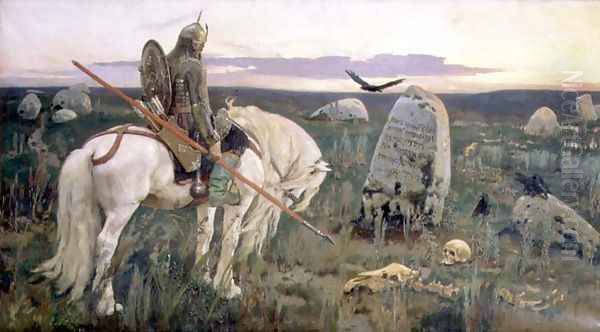
Vasnetsov was also a highly influential figure in Russian stage design. Collaborating frequently with Savva Mamontov's Private Opera, he created sets and costumes for several landmark productions, most notably Alexander Ostrovsky's play The Snow Maiden (for which Nikolai Rimsky-Korsakov later wrote his famous opera). His designs moved away from conventional, often historically inaccurate stagecraft, towards evocative, atmospheric settings that captured the spirit of Russian folklore and history. He designed costumes for Pyotr Ilyich Tchaikovsky's Eugene Onegin. His innovative approach, integrating set, costume, and lighting into a unified artistic whole, profoundly impacted the development of modern Russian theatre design, influencing later artists like Léon Bakst and Alexandre Benois of the Ballets Russes.
Relationships with Contemporaries and Influence
Throughout his career, Vasnetsov maintained connections with many leading figures in Russian art and culture. His early friendship with Ilya Repin remained important, though their artistic paths diverged. He deeply respected Ivan Kramskoi as a mentor figure in the Peredvizhniki movement. His teacher, Pavel Chistyakov, provided a crucial academic foundation.
His younger brother, Apollinary Vasnetsov (1856-1933), also became a distinguished artist, known primarily for his historical landscape paintings reconstructing medieval Moscow. While influenced by Viktor, Apollinary developed his own distinct style. The brothers were close, and Apollinary contributed to the design of Viktor's Moscow house, but specific collaborative artworks are not widely documented, suggesting they largely pursued independent creative paths while sharing a common interest in Russian history and culture.
Vasnetsov's circle at the Abramtsevo Colony included Savva Mamontov, Vasily Polenov, Mikhail Vrubel, Valentin Serov, and Konstantin Korovin. These interactions fostered a rich exchange of ideas and contributed to the flourishing of the Neo-Russian style. His historical paintings resonated with the work of Vasily Surikov, another master of large-scale Russian historical canvases. While Vasnetsov focused more on myth and legend, both artists sought to visually define key moments and figures from Russia's past.
Although Vasnetsov's embrace of myth and romanticism set him apart from staunch Realists like Isaac Levitan (primarily a landscape painter), his work was influential. It provided a bridge between 19th-century Realism and the emerging Symbolist movement in Russia, represented by artists like Vrubel. His emphasis on national themes, decorative qualities, and spiritual depth resonated with the younger generation of artists associated with the World of Art (Mir Iskusstva) movement, even if they sometimes reacted against what they perceived as his excessive nationalism. The great collector Pavel Tretyakov recognized Vasnetsov's importance early on, acquiring many of his key works for his gallery.
Later Years and Enduring Legacy

Viktor Vasnetsov continued to work prolifically into the 20th century. He witnessed the tumultuous events of the Russo-Japanese War, the 1905 Revolution, World War I, and the Bolshevik Revolution of 1917. Despite the upheavals, he chose to remain in Russia. Reports suggest he declined offers to join the Bolshevik party, preferring to stay focused on his art in his Moscow home-studio. His later years were marked by some anxiety about the future of Russia and its cultural heritage under the new regime.
Although his style might have seemed less radical compared to the avant-garde movements flourishing in the early 20th century, Vasnetsov's status as a national artist remained significant. He continued to work on historical and folklore themes, as well as some portraiture. He passed away in his Moscow home on July 23, 1926, at the age of 78.
Viktor Vasnetsov's legacy is immense. He played a crucial role in broadening the scope of Russian art, legitimizing folklore and fairy tales as subjects for serious painting. He was a pioneer of the Neo-Russian style, creating a powerful visual language that celebrated national identity through a romantic synthesis of history, myth, and folk tradition. His monumental works, particularly the murals in St. Vladimir's Cathedral, revitalized Russian religious art. His innovations in stage design left a lasting mark on Russian theatre.
While perhaps not as widely known internationally as some of his Russian contemporaries, Vasnetsov's work holds a cherished place within Russia. Paintings like The Bogatyrs are instantly recognizable national icons. He succeeded in creating art that was both deeply personal and profoundly resonant with the collective imagination of his homeland, securing his position as a true bard of Russian visual culture.
Collections and Exhibitions
Viktor Vasnetsov's works are prominently displayed in major Russian museums. The State Tretyakov Gallery in Moscow holds the most extensive collection, including masterpieces like The Bogatyrs, Alenushka, Ivan Tsarevich Riding the Grey Wolf, and many others, along with numerous sketches and studies. The Viktor Vasnetsov House-Museum in Moscow, operating as a branch of the Tretyakov, offers an immersive experience of his life and work environment.
The State Russian Museum in St. Petersburg also houses important works by Vasnetsov. His monumental murals can be seen in situ at St. Vladimir's Cathedral in Kiev and the State Historical Museum in Moscow. The Vyatka Regional Art Museum, named after Viktor and Apollinary Vasnetsov, located in Kirov (formerly Vyatka), holds works by both brothers, reflecting their regional origins.
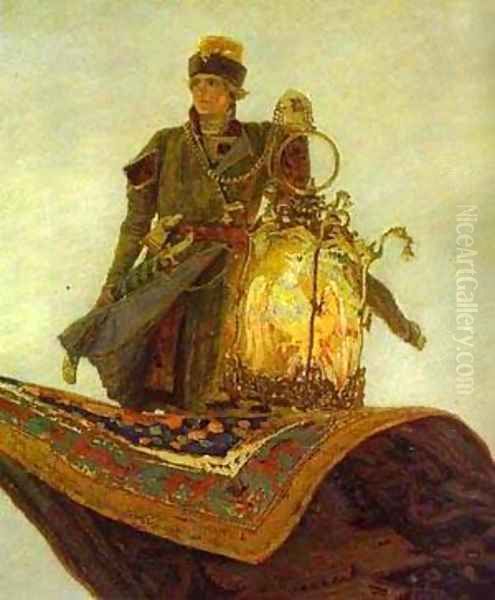
Internationally, Vasnetsov's work gained exposure during his lifetime, notably at the Paris Exposition Universelle of 1900, where his contributions to the Russian pavilion showcased the vitality of the Neo-Russian style. While major retrospectives outside Russia are rare, his key works are frequently included in exhibitions dedicated to Russian art, ensuring his contribution to world art history continues to be recognized.